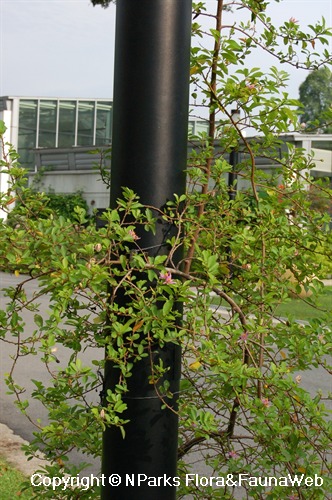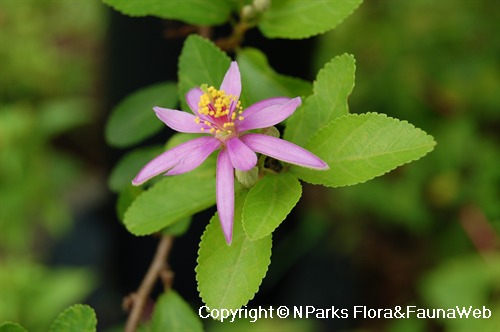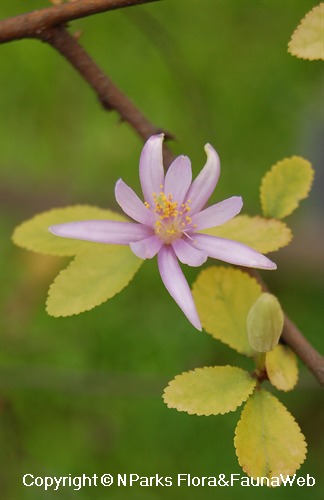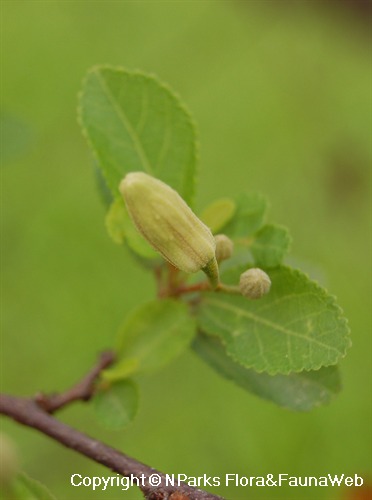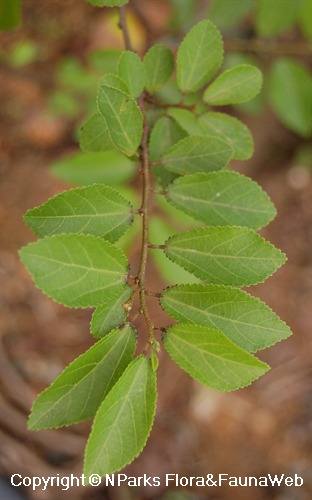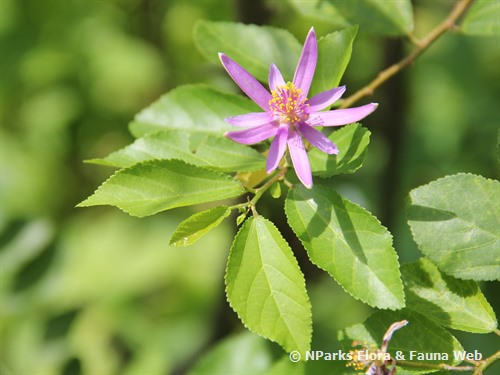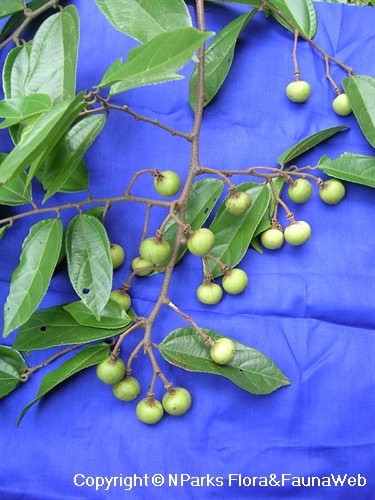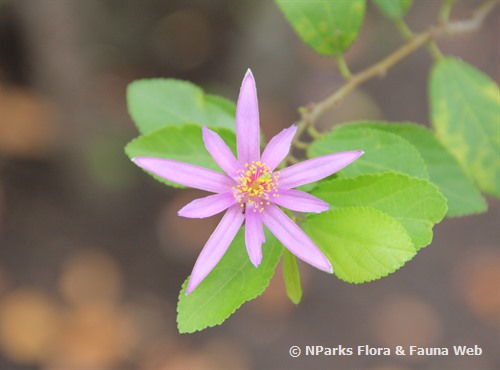
Back
Grewia occidentalis
| Family Name: | Malvaceae |
| Common Name: | Cross-berry, Four-corners, Lavender Starflower |
Name
Classifications and Characteristics
| Plant Division | Angiosperms (Flowering Seed Plants) (Dicotyledon) |
|---|---|
| Plant Growth Form | Shrub, Climber |
| Lifespan (in Singapore) | Perennial |
| Mode of Nutrition | Autotrophic |
| Plant Shape | Irregular |
| Maximum Height | 3 m to 6 m |
Biogeography
| Native Distribution | Southern Africa |
|---|---|
| Native Habitat | Terrestrial |
Description and Ethnobotany
| Growth Form | A deciduous climber with multiple stems in dense thickets, but a shrub or tree in open woodlands. This species is evergreen when grown under optimal growing conditions. |
|---|---|
| Trunk | Bark is smooth and grey-brown. |
| Foliage | Leaves green and ovate or elliptic with serrulate leaf margin. Alternate arrangement of leaves. |
| Flowers | Flowers pink to mauve and shaped like stars (3.5 cm in diameter). They are arranged in inflorescences classified as axillary cymes. |
| Fruit | Fruits are initially green, become yellow and then turn reddish-brown or purple at maturity. Each fruit consists of 4 spherical lobes of the same size fused together. |
| Habitat | Found in many types of habitats, such as open woodlands, forest margins, semiarid habitats, coastal dunes, and montane forests. It occurs at altitudes of 0 - 1500 m. |
| Cultivation | Plant in soil that is rich in compost and able to retain moisture. This species can tolerate moderate amounts of wind and salt and hard pruning. Light pruning will promote a fuller canopy. |
| Etymology | The genus name "Grewia" was named after Nehemiah Grew, an English doctor who lived from 1641 to 1712. The specific epithet "occidentalis" means coming from the west. |
| Ethnobotanical Uses | Edible Plant Parts : Edible Fruits Food (Fruit or Vegetable) (Herb or Spice) |
Landscaping Features
| Landscaping | This species can be planted near buildings and pavement, because the roots will not spread and damage them. It can be used for a wide variety of purposes: 1) topiary (trained to take various shapes), 2) espalier (trained to have a tree-like form), 3) ground cover, 4) trellis cover, 5) hedge and 6) edge plants for informal gardens. This species is ideal for attracting birds and butterflies to your garden. |
|---|---|
| Desirable Plant Features | Ornamental Flowers |
| Landscape Uses | Parks & Gardens, Small Gardens, Trellis / Arbour / Pergola, Hedge / Screening, Topiary, Flowerbed / Border, Groundcover |
Plant Care and Propagation
| Light Preference | Full Sun, Semi-Shade |
|---|---|
| Water Preference | Lots of Water |
| Rootzone Tolerance | Saline Soils / Salt Spray |
| Propagation Method | Seed, Stem Cutting, Ground Layering |
Foliar
| Foliage Retention | Evergreen |
|---|---|
| Mature Foliage Colour(s) | Green |
| Foliar Type | Simple / Unifoliate |
| Foliar Attachment to Stem | Petiolate |
| Foliar Shape(s) | Non-Palm Foliage (Ovate, Elliptical) |
| Foliar Venation | Pinnate / Net |
| Foliar Margin | Serrulate |
Floral (Angiosperm)
| Flower & Plant Sexuality | Bisexual Flowers |
| Flower Colour(s) | Pink |
|---|---|
| Flower Grouping | Cluster / Inflorescence |
| Flower Location | Axillary |
| Individual Flower Shape | Stellate / Star-shaped |
| Inflorescence Type | Cyme |
| Flower Colour(s) Remarks | mauve |
Fruit, Seed and Spore
| Mature Fruit Colour(s) | Brown, Purple |
|---|
Image Repository
Others
| Master ID | 29927 |
|---|---|
| Species ID | 4236 |
| Flora Disclaimer | The information in this website has been compiled from reliable sources, such as reference works on medicinal plants. It is not a substitute for medical advice or treatment and NParks does not purport to provide any medical advice. Readers should always consult his/her physician before using or consuming a plant for medicinal purposes. |

